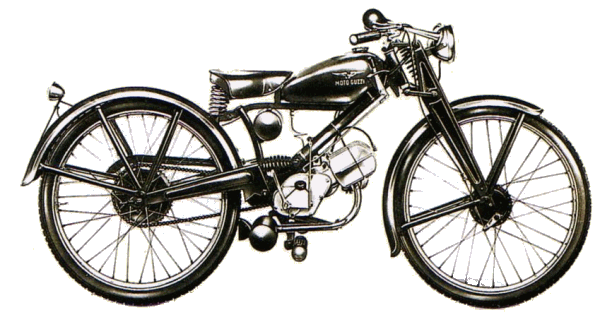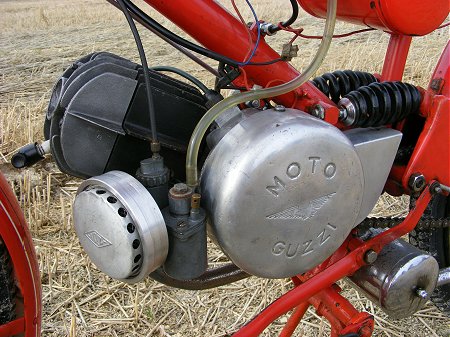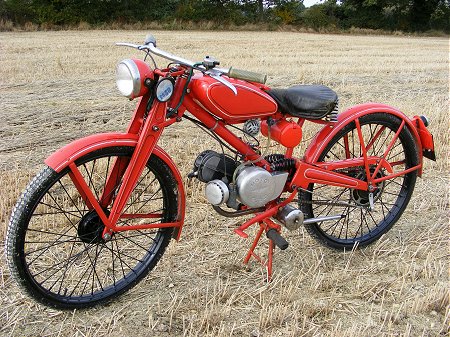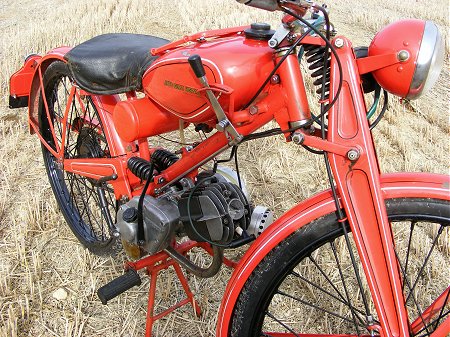 Go
to the Archive index
Go
to the Archive index
While many European manufacturers were following their various developments along the pedal-assisted autocycle theme in the pre-war/post-war periods, there were others evolving lightweight transport methods along very different lines...
As post-war Europe picked itself up and got back to business, there quickly developed a demand for cheap and economic personal transport. Many western European manufacturers simply resumed construction of their outdated, pedal-assisted autocycles, but in post-war Italy there appeared an original autocycling alternative that had been produced without pedals!
With the launch of the 65cc Motoleggera designed by Antonio Meucci, Moto-Guzzi had shown the initiative to step forward ten years! First appearing in early 1946, this revolutionary development was absolutely no autocycle, but a truly practical lightweight motorcycle that would quickly adopt the title of 'Guzzino' - Little Guzzi!

The motor specification comprised a 65cc 2-stroke with cast iron cylinder and alloy head, with rotary valve induction through a hollow LH crank journal, from a Dell'orto MU14B2 carb. A CEV Modello 6100 magset provides sparks, and transmission goes out via a 3-speed gearbox, selected 'old-style' by a hand change lever on the RH side of the petrol tank.
Some aspects of the cycle, like the 26" wheels with adjustable cup & cone bearing arrangements, and the flywheel mag driven batteryless lighting system, will be familiar as contemporary derivations; but not only did this machine have the vision to jump beyond the single-ratio, pedal-assisted autocycle generation, the radical cycle design also looked modern enough to carry it off.
With the imaginative styling proving popular, and an established reputation for reliability, demand for the machine was quickly reaching to other Mediterranean shores. In 1948 Moto-Hispania in Spain became licensed to manufacture and market machines derived from the original Italian Moto-Guzzi, under the name of ISA-Guzzi. So it was that the Guzzino came to being manufactured in 2 different countries at the same time!
Though the Hispania Guzzino was ostensibly the same machine, there were a number of characteristic differences. On the engine side, the cylinder became cast in alloy with an iron liner, and fed from an IRZ14mm carb, while a Femsa MAV200A magset now lit the fires.
Apart from different electrical fittings, the cycle assembly remained pretty much unchanged, but frame serialisation became indicated with an MGH prefix.
Our feature machine displays frame number MGH4130 so is certainly one of the Spanish built models. The fitted engine however wears a cast iron cylinder with offset plug head, and stamped DDG10 (crankcase) & DIB64 (clutch case), with 'stars' before and after the numbers in typical Italian practice. With 'Moto-Guzzi' moulded into the oil filler cap and pressed into the aluminium mag cover, and though the inlet manifold mounts the IRZ Spanish carb, there's little doubt the installed motor is of Italian origin.
Once you've come to terms with the unusual, insect-like appearance of the design, all the controls are actually quite familiar and conventionally disposed. A tap turns on under the left hand side of the fuel tank, there's a flood button on top of the carb, and little flip lever on the back of the air filter to choke on the strangler. The kickstart construction is unusual in that the head rotates about midway down the shank, but works in exactly the same manner as any other device. A few jabs on the starter while twisting open the throttle and variously jiggling with the choke lever soon has the motor firing, and we sit for a while to run our recalcitrant conveyance until it settles down.

The exhaust tone gives a mellow popping note, graduating to a hooverish hum as the revs are twisted up on the throttle. Left hand in the clutch lever, right hand to the gear lever on the tank and click backwards for first, then wind open the twistgrip while feeding in the clutch - and 1st feels like it has a reasonably selected ratio, taking us up to around 12mph before we're back to the tank lever and fumbling to switch up to 2nd.
2nd gear can be built up to 27mph, so the notch into 3rd is made with quite some optimism as to what our Guzzino might achieve, but such hopes are quickly dashed. Top proves to be an overdrive, and far too overgeared for the motor to effectively pull against. You soon find you've got the throttle wound fully open with the little 65cc engine just labouring against the ratio. The bike generally holds between 28 - 32mph on the flat according to conditions, but readily fades even against the lightest incline or headwind.
Pace bike clocked off 37mph on the downhill run, and Guzzino was still building up when we reached the bottom of the dip, so it wasn't revving out by any means and would certainly have crept up a little higher on a longer descent. Confronted with climbing the gradient on the other side of the dip, the result was quite predictable. Guzzino faded fast in 3rd, requiring a switch down to 2nd so we could plod up the other side around 20mph.
We were aware that the recently honed cylinder assembly has not yet bedded in, and fuel in the test bike being several years old and probably verging on stale, so this machines performance may not be wholly representative.
Compared to the generally ineffective brakes on most British built autocycles, Guzzino's stoppers were a considerable improvement. The leverage advantage afforded by the foot operated rear arm ensured this brake proved quite effective, while the front drum was also more than adequate for the bikes performance.
Guzzino's general ride was most commendable when compared to the unforgiving frames of its distant autocycle cousins. The pressed girder fork set didn't look at all busy with the road surface, but smoothed out the bow waves quite efficiently. While the rigid frame of a typical autocycle would be delivering a steady battering to its rider, our undamped swingarm arrangement proves contrastingly bouncy, and coupled with the springy saddle, you flow gently along in an undulating fashion. While one might think this limousine style ride may compromise the handling - not so! Push Guzzino confidently through corners and its manners prove fine, hesitation however may be returned with a wobbly unsurity as to quite where it may be going - but only yourself to blame for that!
Considering the batteryless mag driven lighting system being much the same principle as a typical Villiers powered glimmer, the headlight proved illuminatingly better for night riding, and reasonably suitable to the motorcycle's performance.
We did drain the tank and replace with fresh fuel the following day, to find starting and acceleration appreciably improved. Unfortunately, with appalling weather, having no fitted speedo and no pace bike available, there was no opportunity to repeat the test before the bike was returned to its owner. The conclusion being that a better running performance may well have been achievable.
Being a relatively light and small capacity machine, Guzzino would have been perceived in a similar local commuting role to contemporary autocycles, however its more comfortable ride would enable the advantage of longer journeys without the associated rider fatigue.

Moto-Guzzi manufactured the 65cc Motoleggera 'Guzzino' 1946 - 1954, when it became remodelled into the 65cc Cardellino 1954 - 1956. Engine capacity was increased for the 73cc Cardellino 1956 - 62, then the 83cc Cardellino 1962 - 65. Over this period the cycle chassis evolved with a modified frame to friction damped rear suspension, telescopic fork set, full-width hubs, different mudguards and petrol tank. The form of the engine however remained basically unchanged.
The Spanish built ISA-Guzzi 65cc listed from 1948 - 1963, and Hispania continued other Moto-Guzzi licensed models up to 1979. Beyond the Guzzi license, Moto-Hispania still continue to manufacture a range of light motorcycles and mopeds under their own brands.
Text and photos © 2009 M.Daniels. Original article written for IceniCAM Magazine and website www.icenicam.org.uk Derivative version for first publication licensed to Moto-Guzzi Club GB 'Gambalunga' Magazine, April 2009.